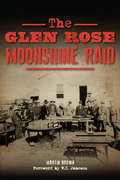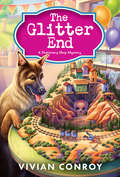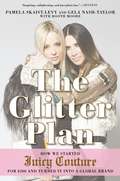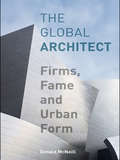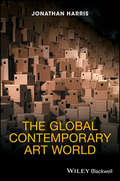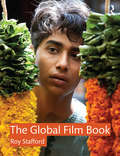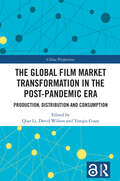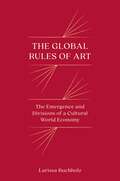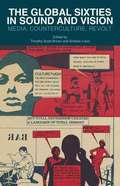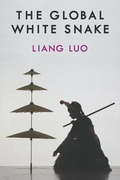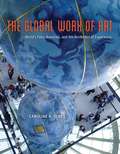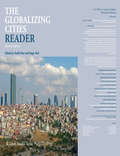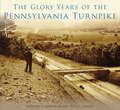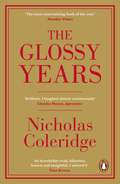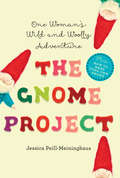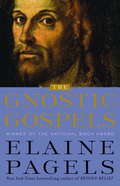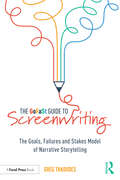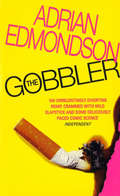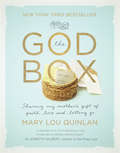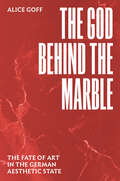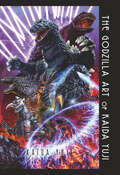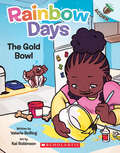- Table View
- List View
The Glen Rose Moonshine Raid
by Martin BrownWith hills studded with whiskey stills and cisterns brimming over with beer, Glen Rose operated in concerted defiance of one of Prohibition's chief champions, Governor Pat Neff. In 1923, Neff dispatched Texas Rangers and undercover agents to do the job of the unwilling local law enforcement. More than fifty men were arrested, including the sheriff and the county prosecutor. Outraged, the town's most prominent citizens stalked the Rangers and their agents, assassinating the primary operative in an ambush and further escalating the affair. Author Martin Brown follows the frenzy of the raid and its aftermath.
The Glitter End (Stationery Shop Mystery #3)
by Vivian ConroyThe third book in the Stationery Shop Mystery Series from Vivian Conroy! Murder is on display in this small-town cozy mystery!Perfect for:For fans of Lauren Elliot and Essie LangFor readers of cozy mysteries and small-town fictionStationery shop owner Delta Douglas is finally settling into small-town life in Tundish, Montana. But with the tourist season drying up, she must find a way to draw in her stationery shop clientele. Well-known artist Tilly Tay is just the ticket—and her new miniature gold mining display is sure to be a hit attraction in town.But on the day of the grand reveal, Delta discovers a tiny prospector dead in the exhibit. That's when a body is found at the nearby motel, perfectly mirroring the miniature murder. Soon enough, Delta's artist guest is suspected of the crime and her shop is suddenly cast under a cloud of bad press. With her faithful Paper Posse at her side, Delta must pull no paper punches to crack the case and save Wanted's reputation before more trouble comes into the fold.
The Glitter Plan
by Booth Moore Pamela Skaist-Levy Gela Nash-TaylorPart memoir, part business manual, and 100% juicy--the inside story of Juicy Couture, one of the most iconic brands of our times While working together at a Los Angeles boutique, Pamela Skaist-Levy and Gela Nash-Taylor became fast and furious friends over the impossibility of finding the perfect T-shirt. Following their vision of comfortable, fitted T-shirts, they set up shop in Gela's one-bedroom Hollywood apartment with $200 and one rule: Whatever they did, they both had to be obsessed by it. The best friends' project became Juicy Couture. Pam and Gela eventually sold their company to Liz Claiborne for $50 million, but not before they created a whole new genre of casual clothing that came to define California cool. Pamela and Gela built an empire from the ground up, using themselves as models to build their patterns and placing their merchandise by storming into stores and handing out samples. They balanced careful growth with innovative tactics--sending Madonna a tracksuit with her nickname, Madge, embroidered on it--and created a unique, bold, and unconventional business plan that was all their own: the Glitter Plan. Now, Pam and Gela reveal the secrets of Juicy's success: how they learned to find and stick with the right colleagues and trust their instincts when it became time to move on to their next project. They also share their missteps and hilarious lessons learned--like the time robbers stole one thousand pairs of maternity shortalls, which the partners took as the first sign to get out of the maternity clothing business. Told in the bright, cheery voice that defines Juicy style even today, The Glitter Plan shows readers how to transform passion and ideas into business success. Aspiring designers, Juicy fans, and business readers of all stripes will be enthralled by the story of spirit and savvy behind Pam and Gela's multimillion-dollar fashion empire.
The Global Architect: Firms, Fame and Urban Form
by Donald McNeillThe Global Architect explores the increasing significance of globalization processes on urban change, architectural practice and the built environment. In what is primarily a critical sociological overview of the current global architectural industry, Donald McNeill covers the "star system" of international architects who combine celebrity and hypermobility, the top firms, whose offices are currently undergoing a major global expansion, and the role of advanced information technology in expanding the geographical scope of the industry.
The Global Contemporary Art World: A Rough Guide
by Jonathan HarrisThe final installment in the critically-acclaimed trilogy on globalization and art explores the growing dominance of Asian centers of art This book takes readers on a fascinating journey around five Asian centers of contemporary art and its myriad institutions, agents, forms, materials, and languages, while posing vital questions about the political economy of culture and the power of visual art in a multi-polar world. He analyzes the financial powerhouse of Art Basel Hong Kong, new media art in South Korea, the place of the Kochi Biennale within contemporary art in India, transnational art and art education in China, and the geo-politics of art patronage in Palestine, and he develops a highly original synthesis of theoretical perspectives and empirical research. Drawing on detailed case studies and personal insights gained from his extensive experience of the contemporary art scene in Asia, Professor Harris examines the evolving relationship between the western centers of art practice, collection, and validation and the emerging “peripheries” of Asian Tiger societies with burgeoning art centers. And he arrives at the somewhat controversial conclusion that dominance of the art world is rapidly slipping away from Europe and North America. The Global Contemporary Art World is essential reading for undergraduates and postgraduate students in modern and contemporary art, art history, art theory and criticism, cultural studies, the sociology of culture, and globalization studies. It is also a vital resource for research students, academics, and professionals in the art world.
The Global Film Book
by Roy StaffordThe Global Film Book is an accessible and entertaining exploration of the development of film as global industry and art form, written especially for students and introducing readers to the rich and varied cinematic landscape beyond Hollywood. Highlighting areas of difference and similarity in film economies and audiences, as well as form, genre and narrative, this textbook considers a broad range of examples and up to date industry data from Europe, Africa, Asia, Australasia and Latin America. Author Roy Stafford combines detailed studies of indigenous film and television cultures with cross border, global and online entertainment operations, including examples from Nollywood to Korean Cinema, via telenovelas and Nordic crime drama. The Global Film Book demonstrates a number of contrasting models of contemporary production, distribution and consumption of film worldwide, charting and analysing the past, present and potential futures for film throughout the world. The book also provides students with: a series of exploratory pathways into film culture worldwide illuminating analyses and suggestions for further readings and viewing, alongside explanatory margin notes and case studies a user friendly text design, featuring over 120 colour images a dynamic and comprehensive blog, online at www.globalfilmstudies.com, providing updates and extensions of case studies in the book and analysis of the latest developments in global film issues.
The Global Film Market Transformation in the Post-Pandemic Era: Production, Distribution and Consumption (China Perspectives)
by David Wilson Qiao Li Yanqiu GuanThis book reviews the development and performance of the global film industry during the COVID-19 pandemic and examines new trends in film production, distribution and consumption through a global lens. The COVID-19 pandemic has had a substantial impact on the global film industry since the beginning of 2020. There has been significant transformation in terms of film production, distribution and consumption. Hollywood, like many national cinemas across the globe, has suffered the most significant impact at all levels: the interruption of new film productions, shutdowns of movie theatres in many countries and delays in the release of new films, among them. Many movies made for cinemas were forced to move from release in theatres to various streaming platforms, and nontraditional production companies continued to grow their market share. This book places the global film industry in a post-Pandemic context. It provides detailed analyses of specific systems of film production, distribution and consumption in national cinemas, as well as in Hollywood, while also engaging with the key theoretical and methodological questions from the film studies literature. This volume is a critical reference for students and scholars of film studies and general readers who are interested in the new trends and transformation of the global film industry in a post-Pandemic era.
The Global Rules of Art: The Emergence and Divisions of a Cultural World Economy (Princeton Studies in Global and Comparative Sociology)
by Larissa BuchholzA trailblazing look at the historical emergence of a global field in contemporary art and the diverse ways artists become valued worldwidePrior to the 1980s, the postwar canon of “international” contemporary art was made up almost exclusively of artists from North America and Western Europe, while cultural agents from other parts of the world often found themselves on the margins. The Global Rules of Art examines how this discriminatory situation has changed in recent decades. Drawing from abundant sources—including objective indicators from more than one hundred countries, multiple institutional histories and discourses, extensive fieldwork, and interviews with artists, critics, curators, gallerists, and auction house agents—Larissa Buchholz examines the emergence of a world-spanning art field whose logics have increasingly become defined in global terms.Deftly blending comprehensive historical analyses with illuminating case studies, The Global Rules of Art breaks new ground in its exploration of valuation and how cultural hierarchies take shape in a global context. The book’s innovative global field approach will appeal to scholars in the sociology of art, cultural and economic sociology, interdisciplinary global studies, and anyone interested in the dynamics of global art and culture.
The Global Shelter Imaginary: Ikea Humanitarianism and Rightless Relief (Forerunners: Ideas First)
by Andrew Herscher Daniel Bertrand MonkExamines how the humanitarian order advances a message of moral triumph and care while abandoning the dispossessed Prompted by a growing number of refugees and other displaced people, intersections of design and humanitarianism are proliferating. From the IKEA Foundation&’s Better Shelter to Airbnb&’s Open Homes program, the consumer economy has engaged the global refugee crisis with seemingly new tactics that normalize an institutionally sanctioned politics of evasion. Exploring &“the global shelter imaginary,&” this book charts the ways shelter functions as a form of rightless relief that expels recognition of the rights of the displaced and advances political paradoxes of displacement itself.
The Global Sixties in Sound and Vision
by Timothy Scott Brown Andrew LisonDespite the explosion of interest in the "global 1968," the arts in this period - both popular and avant-garde forms - have too often been neglected. This interdisciplinary volume brings together scholars in history, cultural studies, musicology and other areas to explore the symbiosis of the sonic and the visual in the counterculture of the 1960s.
The Global White Snake (China Understandings Today)
by Liang LuoThe Global White Snake examines the Chinese White Snake legends and their extensive, multidirectional travels within Asia and across the globe. Such travels across linguistic and cultural boundaries have generated distinctive traditions as the White Snake has been reinvented in the Chinese, Japanese, Korean, and English-speaking worlds, among others. Moreover, the inter-Asian voyages and global circulations of the White Snake legends have enabled them to become repositories of diverse and complex meanings for a great number of people, serving as reservoirs for polyphonic expressions ranging from the attempts to consolidate authoritarian power to the celebrations of minority rights and activism. The Global White Snake uncovers how the White Snake legend often acts as an unsettling narrative of radical tolerance for hybrid sexualities, loving across traditional boundaries, subverting authority, and valuing the strange and the uncanny. A timely mediation and reflection on our contemporary moment of continued struggle for minority rights and social justice, The Global White Snake revives the radical anti-authoritarian spirit slithering under the tales of monsters and demons, love and lust, and reminds us of the power of the fantastic and the fabulous in inspiring and empowering personal and social transformations.
The Global Work of Art: World's Fairs, Biennials, and the Aesthetics of Experience
by Caroline A. JonesGlobal biennials have proliferated in the contemporary art world, but artists’ engagement with large-scale international exhibitions has a much longer history that has influenced the present in important ways. Going back to the earliest world’s fairs in the nineteenth century, this book argues that “globalism” was incubated in a century of international art contests and today constitutes an important tactic for artists. As world’s fairs brought millions of attendees into contact with foreign cultures, products, and processes, artworks became juxtaposed in a “theater of nations,” which challenged artists and critics to think outside their local academies. From Gustave Courbet’s rebel pavilion near the official art exhibit at the 1855 French World’s Fair to curator Beryl Madra’s choice of London-based Cypriot Hussein Chalayan for the off-site Turkish pavilion at the 2006 Venice Biennale, artists have used these exhibitions to reflect on contemporary art, speak to their own governments back home, and challenge the wider geopolitical realm—changing art and art history along the way. Ultimately, Caroline A. Jones argues, the modern appetite for experience and event structures, which were cultivated around the art at these earlier expositions, have now come to constitute contemporary art itself, producing encounters that transform the public and force us to reflect critically on the global condition.
The Globalizing Cities Reader (Routledge Urban Reader Series)
by Xuefei Ren Roger KeilThe newly revised Globalizing Cities Reader reflects how the geographies of theory have recently shifted away from the western vantage points from which much of the classic work in this field was developed. The expanded volume continues to make available many of the original and foundational works that underpin the research field, while expanding coverage to familiarize students with new theoretical and epistemological positions as well as emerging research foci and horizons. It contains 38 new chapters, including key writings on globalizing cities from leading thinkers such as John Friedmann, Michael Peter Smith, Saskia Sassen, Peter Taylor, Manuel Castells, Anthony King, Jennifer Robinson, Ananya Roy, and Fulong Wu. The new Reader reflects the fact that world and global city studies have evolved in exciting and wide-ranging ways, and the very notion of a distinct "global" class of cities has recently been called into question. The sections examine the foundations of the field and processes of urban restructuring and global city formation. A large number of new entries focus on the emerging urban worlds of Asia, Latin America and Africa, including Beijing, Bogota, Cairo, Cape Town, Delhi, Istanbul, Medellin, Mumbai, Phnom Penh, Rio de Janeiro, Sao Paulo, and Shanghai. The book also presents cases off the conventional map of global cities research, such as smaller cities and less known urban regions that are undergoing processes of globalization. The book is a key resource for students and scholars alike who seek an accessible compendium of the intellectual foundations of global urban studies as well as an overview of the emergent patterns of early 21st century urbanization and associated sociopolitical contestation around the world.
The Glory Years of the Pennsylvania Turnpike
by Mitchell E. Dakelman Neal A. SchorrThe Pennsylvania Turnpike was opened to traffic on October 1, 1940. Built using the right-of-way and unfinished tunnels of the never completed South Pennsylvania Railroad, it was a supreme achievement of civil engineering. The new highway immediately captured the public's imagination and proved to be an unqualified success. Motorists flocked from around the country to drive on the new "superhighway," and it became a tourist destination in and of itself. But along with that success were planted the seeds of its eventual fall from grace. Under-engineered, poorly maintained, and the victim of premature obsolescence, the highway became the object of public scorn in little more than a generation. Only since the turn of the 21st century were real efforts made to change that perception.
The Glory Years of the Pennsylvania Turnpike
by Mitchell E. Dakelman Neal A. SchorrThe Pennsylvania Turnpike was opened to traffic on October 1, 1940. Built using the right-of-way and unfinished tunnels of the never completed South Pennsylvania Railroad, it was a supreme achievement of civil engineering. The new highway immediately captured the public's imagination and proved to be an unqualified success. Motorists flocked from around the country to drive on the new "superhighway," and it became a tourist destination in and of itself. But along with that success were planted the seeds of its eventual fall from grace. Under-engineered, poorly maintained, and the victim of premature obsolescence, the highway became the object of public scorn in little more than a generation. Only since the turn of the 21st century were real efforts made to change that perception.
The Glossy Years: Magazines, Museums and Selective Memoirs
by Nicholas Coleridge'The most entertaining book of the year' Sunday Times _____________________________________________________Diana touched your elbow, your arm, covered your hand with hers. It was alluring. And she was disarmingly confiding."Can I ask you something? Nicholas, please be frank..."Over his thirty-year career at Condé Nast, Nicholas Coleridge has witnessed it all. From the anxieties of the Princess of Wales to the blazing fury of Mohamed Al-Fayed, his story is also the story of the people who populate the glamorous world of glossy magazines. With relish and astonishing candour, he offers the inside scoop on Tina Brown and Anna Wintour, David Bowie and Philip Green, Kate Moss and Beyonce; on Margaret Thatcher's clothes legacy, and a surreal weekend away with Bob Geldof and William Hague. Cara Delevingne, media tycoons, Prime Ministers, Princes, Mayors and Maharajas - all cross his path.His career in magazines straddles the glossies throughout their glorious zenith - from the 1970s, 1980s and 1990s to the digital iterations of the 21st century. Having cut his teeth on Tatler, and as Editor-in-Chief of Harpers & Queen, he became the Mr Big of glossy publishing for three decades.Packed with surprising and often hilarious anecdotes, The Glossy Years also provides perceptive insight into the changing and treacherous worlds of fashion, journalism, museums and a whole sweep of British society. This is a rich, honest, witty and very personal memoir of a life splendidly lived.__________________________________________________________'An entertaining whirlwind' Evening Standard'Gentle, jolly . . . Blissfully funny' Sunday Telegraph'An irresistible read, hilarious, honest and insightful. I adored it' Tina Brown'Sparkling' Spectator'Forthright, witty and gossipy . . . a passion for glossy magazines shines through this effervescent memoir' Sunday Express
The Gnome Project: One Woman's Wild and Woolly Adventure
by Jessica Peill-MeininghausWhat do you do when life is too chaotic? How about felting a gnome? Or 365 of them, one for each day of the year. Artist and wool crafter Jessica Peill-Meininghaus decided that she needed a project to teach herself follow-through in life. She settled on making one of her popular felted-wool gnomes every day for a year. With pipe cleaners and wool roving, amidst the chaos of raising four children and moving cross-country, Peill-Meininghaus felted her way through hundreds of charming, pointy-hatted, often bearded characters. Lavishly decorated with photos of each charming creation, The Gnome Project is the surprising and magical story of what happens when we commit to something small. (Hint: It's something very big, as in making life more meaningful.) Here is her inspirational tale, complete with gnome-making instructions.
The Gnostic Gospels: Heracleon's Commentary On John (Modern Library 100 Best Nonfiction Books)
by Elaine PagelsDiscussion of early church writings discovered in 1945, and of how Christianity evolved.<P><P> Winner of the National Book Award
The GoFaSt Guide To Screenwriting: The Goals, Failures, and Stakes Model of Narrative Storytelling
by Greg TakoudesCreator of the GoFaSt Model, author Greg Takoudes introduces a comprehensive study of the structural models of screenwriting and provides readers with an adaptive framework for writing successful scripts. With a new approach which reframes discussions and offers alternatives to students and writers who find conventional models creatively constricting, Takoudes draws from both teaching and professional experience to provide a new model of screenwriting that is designed to be adaptive to various types of scripts. The book is structured in three parts. First, it introduces the GoFast Model – allowing for less orthodox writers to keep their unique voices by breaking scripts down into smaller parts and encouraging more flexibility to write in an organized way, without feeling stifled. Second, the book explores several writing scenarios – featuring the practical uses of the model and a step-by-step script structure spanning chapters on a horror, superhero, and heist movie. Third, it concludes with detailed case studies exploring how the GoFaSt Model can be applied to break down scripts including Get Out, The Marvelous Mrs Maisel, and Portrait of a Lady on Fire. It is an ideal text for screenwriting students and aspiring screenwriters interested in learning how working writers put structural models into practice, as well professional screenwriters, producers, and development executives looking for new ways to think about writing, feedback, and development.
The Gobbler
by Adrian EdmondsonJulian Mann, the hard drinking, preening, and sexually provocative star of the TV sitcome Richard the Nerd, feels caught on the horns of a dilemma: should he be concentrating on his career, which is on the slide after an unseemly bout of fisticuffs at the BAFTA awards; or following his baser instincts and bedding every young girl in sight?His twin dreams of comic immortality and a penthouse flat full of booze and young models seem to be frustrated by his wife and children; by Tom, his wife's best friend from university days, a pretentious 'National Theatre Player' who appears to be competing with Julian on the small sreen and in the bedroom; by the tax man, who's chasing him for sixty thousand pounds; and by Lillith, a psychotic fan, and member of a strange Herculean cult whose eight-year cycle of death and regeneration might augur Julian's imminent nemesis...
The God Box: Sharing My Mother's Gift Of Faith, Love And Letting Go
by Mary Lou QuinlanAfter Mary Lou's mother passed away, she went searching for the God Box. But rather than one box, Quinlan found 10 containers stuffed with hundreds of origami-like folded papers. Covering the last 20 years of her mother's life, the notes contained a treasure of brief prayers for family, friends and people she had never even met. Note by note, Quinlan discovered the greatest lesson her mother could impart: the importance of letting go in order to live. Poignantly written and beautifully designed, The God Box is a gift for every parent, every son or daughter, every person who trusts in the permanence of love and the power of prayer.
The God behind the Marble: The Fate of Art in the German Aesthetic State
by Alice GoffA history of Germans’ attempts to transform society through art in an age of revolution. For German philosophers at the turn of the nineteenth century, beautiful works of art acted as beacons of freedom, instruments of progress that could model and stimulate the moral autonomy of their beholders. Amid the Revolutionary and Napoleonic wars, Germans struggled to uphold these ideals as they contended with the destruction of art collections, looting, and questions about cultural property. As artworks fell prey to the violence they were supposed to transcend, some began to wonder how art could deliver liberation if it could also quickly become a spoil of war. Alice Goff considers a variety of works—including forty porphyry columns from the tomb of Charlemagne, the Quadriga from the Brandenburg Gate in Berlin, the Laocoön group from Rome, a medieval bronze reliquary from Goslar, a Last Judgment from Danzig, and the mummified body of an official from the Rhenish hamlet of Sinzig—following the conflicts over the ownership, interpretation, conservation, and exhibition of German collections during the Napoleonic period and its aftermath.
The Godfather Trilogy (SparkNotes Film Guide)
by SparkNotesThe Godfather Trilogy (SparkNotes Film Guide) Making the reading experience fun! SparkNotes Film Guides are one-stop guides to great works of film–masterpieces that are the foundations of filmmaking and film studies. Inside each guide you&’ll find thorough, insightful overviews of films from a variety of genres, styles, and time periods. Each film guide contains:Information about the director and the context in which the film was made Thoughtful analysis of major characters Details about themes, motifs, and symbols Explanations of the most important lines of dialogue In-depth discussions about what makes a film so remarkable SparkNotes Film Guides are an invaluable resource for students or anyone who wants to gain a deeper understanding of the great films they know and love.
The Godzilla Art of KAIDA Yuji
by Yuji KaidaMarvel at this spectacular collection of full-colour graphic art of Godzilla and other Toho movie monsters by renowned artist KAIDA Yuji.For fans of big-screen monster films, KAIDA Yuji is a very well known name. Best known for his vivid illustrations of Godzilla and other popular Toho kaiju, some of Mr KAIDA's most beautiful work is presented here in this full-color flexicover volume. This book's 128 pages are packed with lush artwork, including a brand new piece showing Godzilla in London, created especially for this book.Whether you are an admirer of this Japanese master's work or just a fan of monster movie art, this book is an essential purchase!
The Gold Bowl: An Acorn Book (Rainbow Days)
by Valerie BollingZoya makes Coco a golden birthday present in this full-color book perfect for beginning readers!Pick a book. Grow a Reader!This series is part of Scholastic's early reader line, Acorn, aimed at children who are learning to read. With easy-to-read text, a short-story format, plenty of humor, and full-color artwork on every page, these books will boost reading confidence and fluency. Acorn books plant a love of reading and help readers grow!It’s Coco’s birthday and Zoya wants to give her pup the perfect present. She tries out a few ideas -- including a yarn necklace and colorful frosted treats. But she finally decides to paint Coco’s bowl gold. With some paint and LOTS of glitter, Zoya creates a gift Coco is sure to love!With Kai Robinson's vibrant, full-color artwork and Valerie Bolling's engaging, easy-to-read text throughout, this sparkly series is perfect for beginning readers!
